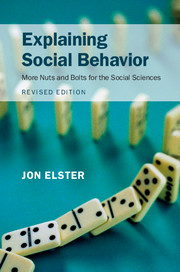3 - Interpretation
from I - Explanation and Mechanisms
Published online by Cambridge University Press: 05 August 2015
Summary
Interpretation and explanation
In many writings on the humanities, the focus has been on interpretation rather than explanation. In the German tradition, a contrast was often drawn between the “spiritual sciences” (Geisteswissenschaften) and the natural sciences (Naturwissenschaften). In the former, we are told, the proper procedure is that of interpretation or “understanding” (Verstehen). For the latter the appropriate language is that of explanation (Erklären). Max Weber wrote, for instance, that natural science does not aim at “understanding” the behavior of cells.
We may then ask whether the social sciences rely on understanding or on explanation. I believe this question is wrongly put. In my view, to interpret is to explain. Interpretation is nothing but a special case of the hypothetico-deductive method (Chapter 1). Scholars in the humanities cannot, for instance, use “empathy” as a privileged shortcut to the interpretation of behavior, since one scholar's empathetic understanding may differ from that of another. To decide among conflicting interpretations they have to confront these interpretive hunches or hypotheses (for that is what they are) with experience. As I argued in, experience includes not only the facts we are trying to understand, but also novel facts that we might not otherwise have thought about investigating.
Interpretation is directed to human actions and to the product of human actions, such as works of art. In Chapter 16 I address the issue of interpretation of literary works, more specifically works in which we need to understand the actions of the characters as well as the choices of the author. In trying to understand other literary works, as well as the “wordless arts” of painting, sculpture, or instrumental music, this two-tier issue does not arise. Yet in these art forms too, the choices of the artist lend themselves, in principle, to much of the same analysis as that which I shall propose for authorial decisions. The artists make choices according to some criterion of “betterness” that neither they nor we may be able to formulate explicitly, but that is revealed in practice when they discard one draft, one sketch, or one recording in favor of another. Yet the relation between the criterion of betterness and human psychology is more complicated and less well understood in the wordless arts than in (classical) fiction. I shall not attempt to deal with them.
Information
- Type
- Chapter
- Information
- Explaining Social BehaviorMore Nuts and Bolts for the Social Sciences, pp. 40 - 54Publisher: Cambridge University PressPrint publication year: 2015
